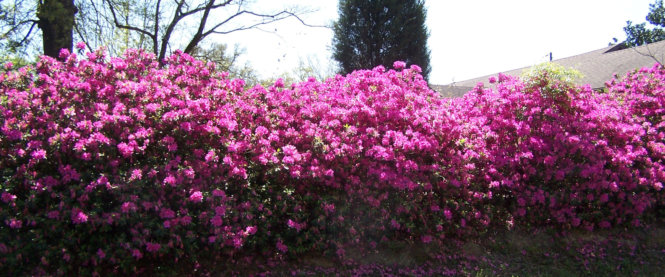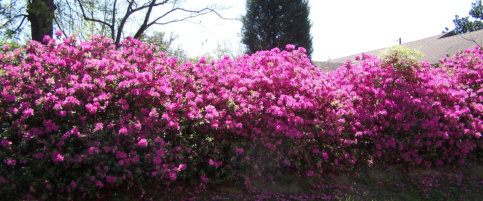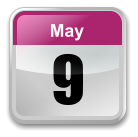


© Keep Saraland Beautiful. All Rights Reserved. Website design and hosting by North Mobile Internet Services, Inc.

KeepSaralandBeautiful

Next Meeting
Meetings are held on the 2nd Thursday of
every other month at 12 noon at the
Saraland Chamber Offices.

KSB GARDENING NEWS FROM JAMES MILES
Mayor Dr. Howard Rubenstein,
Council Chair Joe McDonald,
Council Members: Newton Cromer, Wayne Biggs, Natalie Moye and Veronica Hudson
December 2020
Hello December! The morning low on Dec. 1st being 30° F could result in damage to plants typically tolerant of such lows. We lacked the
acclimation period necessary for the plants to adjust and shift to a dormant or near dormant state. Acclimation periods normally consist of at
least a couple of weeks with low temperatures in the 40’s. Without that acclimation period plant tissue will be damaged. Some of the damage will
be obvious within a few days of the freeze even, others may not be apparent until spring green-up. Bottom line, don’t be in a hurry to start
pruning out the plant material. Continue to irrigate during this transition period.
What should we be doing in the landscape? You can continue planting dormant, container, and bare-root plant material but delay planting
around freeze events. You can also plant winter hardy annuals and vegetables. If you didn’t plant vegetables in your vegetable garden and don’t
intend to, you can plant cool-season cover crops like ryegrass, clover, wheat, turnips, or radishes. This will serve as a source of organic matter
in the spring when you till it in or allow it to die and decompose on the surface. The key to cover crops is to not let them go to seed. You must
terminate them before they go to seed, else they will begin to compete with your desirable crops.
Now is the perfect time to send in a soil sample to the Auburn Soil Testing Lab. You can pick up the soil test boxes from the Alabama
Cooperative Extension Office, 1070 Schillinger Rd. N., Mobile AL 36608. Once you get the results back, if it calls for lime, apply according to the
recommendations ASAP. It takes lime months to work and soil moisture is key.
Because November was relatively dry and unseasonably warm many cool-season weeds were delayed in germinating. Evaluate your lawn to
determine if the cool-season weeds have begun to germinate. If they have not, you can treat with a pre-emergent herbicide to control them.
Here is a list of products: https://www.aces.edu/wp-content/uploads/2020/02/IPM-0590-Home-Lawns-Chemical-Control_022520L-G-copy.pdf
Make sure to follow the labeled directions.
Holiday Interest Links
Poinsettia Care: https://nwdistrict.ifas.ufl.edu/hort/2016/12/22/poinsettia-care/
Live Christmas Tree Care: http://www.southernchristmastrees.org/TreeCare.html
Gift ideas
Gardening tools
Garden bench
Your favorite or heirloom plants
Decorative pots
Birdfeeders
Merry Christmas and Happy New Year!
November 2020
This year continues to present challenges even in the garden and landscape. Because of the recent storms and other weather trends, our
plants are as stressed as ever. Back to back hurricanes have stripped leaves, broken limbs, twisted main trunks, wallowed out soil near the
base of plants, and damaged roots. Anyone of those can induce major stress, but a plant suffers more than one it can be devastating. Some
plants that were defoliated are trying to leaf back out now. This process is using energy the plants were storing for next year. The effect could
be reduced performance (blooms and/or fruit) next year. I have noticed that some plants have exhibited dieback of smaller limbs after
defoliation. I am not sure how severe this dieback will be. What can we do to reduce the stress on our plants? The most important thing would
be to make sure the plants are not drought-stressed. Continue to water if you are not getting regular rain in your area. Repack loosened soil at
the base of the plant, making sure not to pile soil high on the main trunk. If the plant is wobbly, stabilize it with stakes. Prune out any broken or
dead branches.
Safety tip: If you have a lot of trees in your landscape, please look up as you are outside. There could be some broken limbs barely hanging in
the trees that could fall anytime.
Falling limbs can cause severe injury, be careful!
Raking leaves is a common practice this time of year. For some gardeners, it is a matter of neatness, but it is important to remove leaves from
turfgrass. Layers/piles of leaves can smoother your turfgrass and result in dead spots the following spring. Turfgrass growth has slowed the
past few weeks but it is still green. Even with the warming trends we will be experiencing in the next few weeks do not fertilize. Just keep it
from being drought-stressed. You don’t have to go overboard with watering, especially if you are getting regular rains.
The satsuma crop is looking very good this year and local fruit is abundant. If you have a tree or two in your landscape, you don’t have to pick
them all one time. The tree will keep the fruit fresher than you can in the house, this goes for all citrus.
It’s planting time! You can plant all of your woody container plants now. Resist the mistake of planting too deep. You still have time to plant
strawberries. The vegetables that can be planted now are all your Cole crops, leafy vegetables, etc. (Turnips, Collards, Mustard, Lettuces,
Spinach, Broccoli, Cauliflower, Brussel Sprouts, Cabbage, etc.) This is my favorite time to garden.
August 2020
This is the time of year that is difficult to find the motivation to get out and brave the heat, mosquitoes, etc. In addition to the regular outdoor
activities, we should start planning our fall garden strategies, fall vegetables, cover crops, pollinators, crop rotation, etc. Some of this can be on
the inside and on the computer. Start checking seed companies’ websites for new varieties and deals. Consider combining order with friends
and neighbors for bulk pricing and possibly free shipping.
Now back to the not so fun part. Weeds!
You must stay on top of weeds. Your plan should be multi-faceted and specific to the area and weeds. A major key to weed control is preventing
them from developing seeds. They should not be allowed to flower or put on seed heads.
Turf
Treat for Molecricket in the areas mapped in April.
Spittle Bugs have been active for a couple of months now, continue to scout and treat when needed.
Continue to monitor for Spittle Bugs especially on St. Augustine and treat if they are detected.
Fertilize St. Augustine, Bermuda, and Zoysia grasses with 24-6-12 @ 4 lbs. per 1,000 ft2 or according to soil test results.
Fruits
This is a critical period for fruit trees with a crop on them. Irrigate regularly to ensure fruit and sugar development, sizing, and reduced stress on
the plant. Fruits like muscadines should be cleaned up after harvesting to ensure no fruit remains on the plants and lead to pest problems.
Vegetables
This is the time to solarize sections of your garden to reduce soil-borne pests. Here is a link to a publication that describes solarization in detail.
https://www.aces.edu/blog/topics/lawn-garden/soil-solarization-for-control-of-nematodes-soilborne-diseases/
July 2020
We have now entered our regular summer pattern of daily afternoon showers. Though the rains are beneficial they come with a downside.
They increase disease pressure exponentially. Keep an eye out for the early signs and have a plan in place. Your plan may be to prune, rogue,
replant, and/or to treat. A good plan will involve more than one of those tactics to reduce losses.
Turf
Treat for Molecricket in the areas mapped in April.
Spittle Bugs have been active for a couple of months now, continue to scout and treat when needed.
Continue to monitor for Spittle Bugs especially on St. Augustine and treat if they are detected.
Fertilize Centipede with 15-0-15 @ 6 lbs. per 1,000 ft2 or according to soil test results.
Fruits
Now is a good time to develop a bird damage plan to protect figs, persimmons, and other late summer and fall fruits. Bird netting is very
effective, but you must plan for framing, adequate sizing, and time to install.
Start planning for planting strawberries. You will order them at the end of the month or in August. You will plant them in October thru November.
A couple of the more popular varieties are Chandler and Camorosa.
Fertilize your fruit trees now according to your soil test report. If you did not have your soil tested some general recommendations are: tree fruits
10-10-10 ½ lb. per year of age; bush or vine fruits 10-10-10 1/3 lb. per year of age. Spread the fertilizer out at the dripline and not near the main
trunk.
Vegetables
Plant pumpkins the first half of the month to have a Halloween harvest. Select varieties that state powdery mildew resistance for a better
chance of success.
Propagation
There is still time to start softwood cutting from most ornamental and some fruit plants. It’s important to make sure your cutting tools are
sanitized before cutting and between taking cuttings from different plants.
June 2020
Last month we were extremely dry. That is a double-edged sword in the plant world. Dry foliage equals reduced disease pressure, but dry soil
equals stressed poor performing plants. Now that we are starting to get some regular showers, watch for early signs of diseases. If you detect a
disease you can prune the infected leaf or shoot off, treat with a fungicide, or both. The key will be to not let the disease get ahead of you.
Turf
Fertilize St. Augustine, Bermuda, Zoysia, and Bahia with 24-6-12 @ 4 lbs. per 1,000 ft2 or equivalent.
Apply a post-emergent herbicide to areas where weeds are present. (A list of products and categories can be found in IPM-590 @
https://www.aces.edu/wp-content/uploads/2020/02/IPM-0590-Home-Lawns-Chemical-Control_022520L-G-copy.pdf) You can apply pre-
emergent herbicide if there is a history of re-occurring annual weeds. (Read the label carefully as some products may have temperature and/or
growth stage restrictions)
Continue to watch for Spittle Bugs and Chinch Bugs and treat if needed.
Fruits and Ornamentals
This is a great time to take soft-wood cuttings. Take them in the morning and keep them hydrated. Some will root better with a rooting hormone
which you can purchase at most garden centers. Some plants can be layered for a quicker easier process of propagation.
Webworms and tent caterpillars have started to appear. The webs and nests are still small and easy to cut out. Treatments are difficult in large
trees and not very effective because of the protective webbing. Early detection and removal is very effective.
Fertilize these plants. Make sure to apply evenly around the dripline and not in piles.
Vegetables & Herbs
Continue to plant warm-season, heat-tolerant vegetables like squash, cucumbers, peppers, eggplants, and okra. Along with that, most of your
herbs will last through the summer with a single planting. But with the recent rains, Basil may begin to decline and may need to be replanted.
We've been seeing high numbers of caterpillars for the past few weeks. Scout your plants and treat them with the appropriate product. Products
are more effective while the caterpillars are still small.
For produce you are not growing, please visit and support our local farmers. You can locate them at Farmer’s Markets or direct to the farm. Here
is a list of local Farmer’s Markets http://fma.alabama.gov/mapmarkets.aspx?County=MOBILE&OrgType=Market
Enjoy the outdoors!
May 2020
Controlling weeds will be a major chore from now until the first killing frost this fall. Mulching is one way to reduce the weed population. There
are some herbicides that are selective and will not harm your desirable plants. Read the labels on these products carefully, there may be
restrictions on what part of the landscape they can be applied and plants that are tolerant to them. Also, look for temperature restrictions, some
products should not be applied when the air temperature is above 80°F.
Newly planted plants will need a little extra TLC. We have entered a dry period for most of the county so irrigating regularly will reduce the
stress on new plantings and increase their survival rate. When watering a standard measure is 1” of water per week. Another technique is
making sure you are wetting the soil down to 4” - 6”.
Insect activity is ahead of schedule so start scouting now for insects that we usually see in late May or June. An effective insect management
plan starts with scouting, identification, and taking actions when the pest population stage is present at the appropriate stage of the lifecycle.
You can continue to plant summer bedding plants, heat tolerant vegetables and container plants. Again, pay particular attention to watering
them and have a long-range plan. Mulch around these new plants and freshen up existing mulch.
Fertilize your turf areas according to your soil test results or with a low phosphorus fertilizer such as 15-0-15 at a rate of 6 lbs. per 1,000 ft2.
Now is a great time to start planning for your fall garden. Think about what vegetables you like that grow well in the cooler fall and winter
months. Do a little window shopping and talking to your local garden centers about plants that are showy in the fall and winter and think about
color schemes for your landscape.
James
April 2020
We are a little ahead of schedule on fruiting plants. As soon as petals fall from the blooms begin treating for pest on highly pressured fruits like
peaches.
Fertilize woody plants including fruit trees according to your soil test results. Broadcast the fertilizer along the dripline of the plants.
We have been dry for the past few weeks, you can begin regular/weekly irrigation of your lawns. Set timers to activate in the early morning
hours and long enough to wet the soil down 4-6 inches.
Aerify compacted soils. Fertilize St. Augustine, Bermuda, and Zoysia grasses according to soil test or with 24-6-12 at 4 lbs. per 1,000 sq. ft. or
equivalent.
Begin regular mowing of your lawns. Caution not to remove more than 1/3 of the turf height per mowing. Also resist mowing turf at tall heights.
Tall dense canopies invite insects and diseases.
Continue to plant turfgrass and keep it irrigated with frequent events and gradually reduce to once per week.
Map areas where molecrickets are present and tunneling. You will treat these areas the end of June thru the summer.
Apply a fire ant bait according to the label. Make sure the ground is dray and your need 2 hours without rain after application.
Scout roses for insects and diseases and begin treatments at the first sign of either. Remove old flower heads to encourage continued
performance.
Continue to plant container grown plants into your landscape. Also, plant summer annuals.
Now is the time to plant warm season vegetables such as tomatoes, peppers, squash, cucumbers, melons, corn, okra, eggplant, sweet
potatoes, and various herbs. There’s and app for that! We have a free app to serve as a planting guide for vegetables and herbs.
Enjoy the spring, Enjoy the outdoors!
James
March 10, 2020
“Good Morning All,
Continue pruning activities. If you got a late start on pruning that’s ok, you can still get it done. You can plant bulbs and watch for annual
bedding plants at your local garden center. Plant container plants that you held over the winter and continue planting dormant woody plants.
With the warming trend scout for insects on the new growth that is starting to emerge.
Service your tools and equipment: sharpen blades, shovels, hoes, etc. and change the oil in mowers, tillers and other power tools. Don’t forget
to sit down and enjoy the floral show of your landscape, it will be going on for the next few weeks.
“He who plows, hopes; he who fertilizes, begs; but he who prunes, demands.”
February 17, 2020
“With the warm wet winter, our plants are blooming and performing out of sync. With that said don’t rush into landscape/gardening activities too
soon.
Now is perfect time to prune our fruit trees (except blueberries and blackberries) and most of our ornamentals (not azaleas, hydrangeas, and
gardenias)
Apply pre-emergent herbicide to turf areas for control of warm season weeds. Mow winter weeds before making application of pre-emergent to
ensure product gets to the proper zone. Avoid weed & feed type products. Also, do not fertilize now.
You can still plant Irish potatoes, sweet peas, leafy greens, and radishes. Start your warm season vegetables (tomatoes, pepper, etc.) seeds
inside. If you plan on planting tomatoes, watermelons, and squash, apply lime to those areas now.
Continue planting woody plants that are dormant.”






© Keep Saraland Beautiful. All Rights Reserved. Website design and
hosting by North Mobile Internet Services, Inc.

KeepSaralandBeautiful

Next Meeting
Meetings are held on the 2nd Thursday of every other
month at 12 noon at the Saraland Chamber Offices.

KSB GARDENING NEWS FROM JAMES MILES
Join Keep Saraland Beautiful
Business Membership Your business can join KSB for as little as $120 per year. Your dues are used for beautification of the city. When available, Business Members are entitled to the use of a custom-built garbage receptacle to be used at your business' location as long as you are a member. We need to build partnerships with the business community and you can help! Individual Membership Join Keep Saraland Beautiful as an Individual Member for as little as $12 or join as a family for $25. Your dues are used for beautification of the city. We need volunteers to join our organization for the betterment of Saraland!



Mayor Dr. Howard Rubenstein,
Council Chair Joe McDonald,
Council Members: Newton Cromer, Wayne Biggs,
Natalie Moye and Veronica Hudson
December 2020
Hello December! The morning low on Dec. 1st being
30° F could result in damage to plants typically
tolerant of such lows. We lacked the acclimation
period necessary for the plants to adjust and shift to
a dormant or near dormant state. Acclimation periods
normally consist of at least a couple of weeks with
low temperatures in the 40’s. Without that
acclimation period plant tissue will be damaged.
Some of the damage will be obvious within a few
days of the freeze even, others may not be apparent
until spring green-up. Bottom line, don’t be in a hurry
to start pruning out the plant material. Continue to
irrigate during this transition period.
What should we be doing in the landscape? You can
continue planting dormant, container, and bare-root
plant material but delay planting around freeze
events. You can also plant winter hardy annuals and
vegetables. If you didn’t plant vegetables in your
vegetable garden and don’t intend to, you can plant
cool-season cover crops like ryegrass, clover, wheat,
turnips, or radishes. This will serve as a source of
organic matter in the spring when you till it in or allow
it to die and decompose on the surface. The key to
cover crops is to not let them go to seed. You must
terminate them before they go to seed, else they will
begin to compete with your desirable crops.
Now is the perfect time to send in a soil sample to
the Auburn Soil Testing Lab. You can pick up the soil
test boxes from the Alabama Cooperative Extension
Office, 1070 Schillinger Rd. N., Mobile AL 36608.
Once you get the results back, if it calls for lime,
apply according to the recommendations ASAP. It
takes lime months to work and soil moisture is key.
Because November was relatively dry and
unseasonably warm many cool-season weeds were
delayed in germinating. Evaluate your lawn to
determine if the cool-season weeds have begun to
germinate. If they have not, you can treat with a pre-
emergent herbicide to control them. Here is a list of
products: https://www.aces.edu/wp-
content/uploads/2020/02/IPM-0590-Home-Lawns-
Chemical-Control_022520L-G-copy.pdf Make sure
to follow the labeled directions.
Holiday Interest Links
Poinsettia Care:
https://nwdistrict.ifas.ufl.edu/hort/2016/12/22/poinsett
ia-care/
Live Christmas Tree Care:
http://www.southernchristmastrees.org/TreeCare.htm
l
Gift ideas
Gardening tools
Garden bench
Your favorite or heirloom plants
Decorative pots
Birdfeeders
Merry Christmas and Happy New Year!
November 2020
This year continues to present challenges even in
the garden and landscape. Because of the recent
storms and other weather trends, our plants are as
stressed as ever. Back to back hurricanes have
stripped leaves, broken limbs, twisted main trunks,
wallowed out soil near the base of plants, and
damaged roots. Anyone of those can induce major
stress, but a plant suffers more than one it can be
devastating. Some plants that were defoliated are
trying to leaf back out now. This process is using
energy the plants were storing for next year. The
effect could be reduced performance (blooms and/or
fruit) next year. I have noticed that some plants have
exhibited dieback of smaller limbs after defoliation. I
am not sure how severe this dieback will be. What
can we do to reduce the stress on our plants? The
most important thing would be to make sure the
plants are not drought-stressed. Continue to water if
you are not getting regular rain in your area. Repack
loosened soil at the base of the plant, making sure
not to pile soil high on the main trunk. If the plant is
wobbly, stabilize it with stakes. Prune out any
broken or dead branches.
Safety tip: If you have a lot of trees in your
landscape, please look up as you are outside. There
could be some broken limbs barely hanging in the
trees that could fall anytime.
Falling limbs can cause severe injury, be careful!
Raking leaves is a common practice this time of
year. For some gardeners, it is a matter of neatness,
but it is important to remove leaves from turfgrass.
Layers/piles of leaves can smoother your turfgrass
and result in dead spots the following spring.
Turfgrass growth has slowed the past few weeks but
it is still green. Even with the warming trends we will
be experiencing in the next few weeks do not
fertilize. Just keep it from being drought-stressed.
You don’t have to go overboard with watering,
especially if you are getting regular rains.
The satsuma crop is looking very good this year and
local fruit is abundant. If you have a tree or two in
your landscape, you don’t have to pick them all one
time. The tree will keep the fruit fresher than you
can in the house, this goes for all citrus.
It’s planting time! You can plant all of your woody
container plants now. Resist the mistake of planting
too deep. You still have time to plant strawberries.
The vegetables that can be planted now are all your
Cole crops, leafy vegetables, etc. (Turnips, Collards,
Mustard, Lettuces, Spinach, Broccoli, Cauliflower,
Brussel Sprouts, Cabbage, etc.) This is my favorite
time to garden.
August 2020
This is the time of year that is difficult to find the
motivation to get out and brave the heat,
mosquitoes, etc. In addition to the regular outdoor
activities, we should start planning our fall garden
strategies, fall vegetables, cover crops, pollinators,
crop rotation, etc. Some of this can be on the inside
and on the computer. Start checking seed
companies’ websites for new varieties and deals.
Consider combining order with friends and neighbors
for bulk pricing and possibly free shipping.
Now back to the not so fun part. Weeds!
You must stay on top of weeds. Your plan should be
multi-faceted and specific to the area and weeds. A
major key to weed control is preventing them from
developing seeds. They should not be allowed to
flower or put on seed heads.
Turf
Treat for Molecricket in the areas mapped in April.
Spittle Bugs have been active for a couple of months
now, continue to scout and treat when needed.
Continue to monitor for Spittle Bugs especially on St.
Augustine and treat if they are detected.
Fertilize St. Augustine, Bermuda, and Zoysia grasses
with 24-6-12 @ 4 lbs. per 1,000 ft2 or according to
soil test results.
Fruits
This is a critical period for fruit trees with a crop on
them. Irrigate regularly to ensure fruit and sugar
development, sizing, and reduced stress on the
plant. Fruits like muscadines should be cleaned up
after harvesting to ensure no fruit remains on the
plants and lead to pest problems.
Vegetables
This is the time to solarize sections of your garden to
reduce soil-borne pests. Here is a link to a
publication that describes solarization in detail.
https://www.aces.edu/blog/topics/lawn-garden/soil-
solarization-for-control-of-nematodes-soilborne-
diseases/
July 2020
We have now entered our regular summer pattern of
daily afternoon showers. Though the rains are
beneficial they come with a downside. They
increase disease pressure exponentially. Keep an
eye out for the early signs and have a plan in place.
Your plan may be to prune, rogue, replant, and/or to
treat. A good plan will involve more than one of
those tactics to reduce losses.
Turf
Treat for Molecricket in the areas mapped in April.
Spittle Bugs have been active for a couple of months
now, continue to scout and treat when needed.
Continue to monitor for Spittle Bugs especially on St.
Augustine and treat if they are detected.
Fertilize Centipede with 15-0-15 @ 6 lbs. per 1,000
ft2 or according to soil test results.
Fruits
Now is a good time to develop a bird damage plan to
protect figs, persimmons, and other late summer and
fall fruits. Bird netting is very effective, but you must
plan for framing, adequate sizing, and time to install.
Start planning for planting strawberries. You will
order them at the end of the month or in August. You
will plant them in October thru November. A couple
of the more popular varieties are Chandler and
Camorosa.
Fertilize your fruit trees now according to your soil
test report. If you did not have your soil tested some
general recommendations are: tree fruits 10-10-10 ½
lb. per year of age; bush or vine fruits 10-10-10 1/3
lb. per year of age. Spread the fertilizer out at the
dripline and not near the main trunk.
Vegetables
Plant pumpkins the first half of the month to have a
Halloween harvest. Select varieties that state
powdery mildew resistance for a better chance of
success.
Propagation
There is still time to start softwood cutting from most
ornamental and some fruit plants. It’s important to
make sure your cutting tools are sanitized before
cutting and between taking cuttings from different
plants.
June 2020
Last month we were extremely dry. That is a double-
edged sword in the plant world. Dry foliage equals
reduced disease pressure, but dry soil equals
stressed poor performing plants. Now that we are
starting to get some regular showers, watch for early
signs of diseases. If you detect a disease you can
prune the infected leaf or shoot off, treat with a
fungicide, or both. The key will be to not let the
disease get ahead of you.
Turf
Fertilize St. Augustine, Bermuda, Zoysia, and Bahia
with 24-6-12 @ 4 lbs. per 1,000 ft2 or equivalent.
Apply a post-emergent herbicide to areas where
weeds are present. (A list of products and categories
can be found in IPM-590 @
https://www.aces.edu/wp-
content/uploads/2020/02/IPM-0590-Home-Lawns-
Chemical-Control_022520L-G-copy.pdf) You can
apply pre-emergent herbicide if there is a history of
re-occurring annual weeds. (Read the label carefully
as some products may have temperature and/or
growth stage restrictions)
Continue to watch for Spittle Bugs and Chinch Bugs
and treat if needed.
Fruits and Ornamentals
This is a great time to take soft-wood cuttings. Take
them in the morning and keep them hydrated. Some
will root better with a rooting hormone which you can
purchase at most garden centers. Some plants can
be layered for a quicker easier process of
propagation.
Webworms and tent caterpillars have started to
appear. The webs and nests are still small and easy
to cut out. Treatments are difficult in large trees and
not very effective because of the protective webbing.
Early detection and removal is very effective.
Fertilize these plants. Make sure to apply evenly
around the dripline and not in piles.
Vegetables & Herbs
Continue to plant warm-season, heat-tolerant
vegetables like squash, cucumbers, peppers,
eggplants, and okra. Along with that, most of your
herbs will last through the summer with a single
planting. But with the recent rains, Basil may begin to
decline and may need to be replanted.
We've been seeing high numbers of caterpillars for
the past few weeks. Scout your plants and treat them
with the appropriate product. Products are more
effective while the caterpillars are still small.
For produce you are not growing, please visit and
support our local farmers. You can locate them at
Farmer’s Markets or direct to the farm. Here is a list
of local Farmer’s Markets
http://fma.alabama.gov/mapmarkets.aspx?County=M
OBILE&OrgType=Market
Enjoy the outdoors!
May 2020
Controlling weeds will be a major chore from now
until the first killing frost this fall. Mulching is one
way to reduce the weed population. There are some
herbicides that are selective and will not harm your
desirable plants. Read the labels on these products
carefully, there may be restrictions on what part of
the landscape they can be applied and plants that
are tolerant to them. Also, look for temperature
restrictions, some products should not be applied
when the air temperature is above 80°F.
Newly planted plants will need a little extra TLC. We
have entered a dry period for most of the county so
irrigating regularly will reduce the stress on new
plantings and increase their survival rate. When
watering a standard measure is 1” of water per
week. Another technique is making sure you are
wetting the soil down to 4” - 6”.
Insect activity is ahead of schedule so start scouting
now for insects that we usually see in late May or
June. An effective insect management plan starts
with scouting, identification, and taking actions when
the pest population stage is present at the
appropriate stage of the lifecycle.
You can continue to plant summer bedding plants,
heat tolerant vegetables and container plants.
Again, pay particular attention to watering them and
have a long-range plan. Mulch around these new
plants and freshen up existing mulch.
Fertilize your turf areas according to your soil test
results or with a low phosphorus fertilizer such as 15-
0-15 at a rate of 6 lbs. per 1,000 ft2.
Now is a great time to start planning for your fall
garden. Think about what vegetables you like that
grow well in the cooler fall and winter months. Do a
little window shopping and talking to your local
garden centers about plants that are showy in the fall
and winter and think about color schemes for your
landscape.
James
April 2020
We are a little ahead of schedule on fruiting plants.
As soon as petals fall from the blooms begin treating
for pest on highly pressured fruits like peaches.
Fertilize woody plants including fruit trees according
to your soil test results. Broadcast the fertilizer along
the dripline of the plants.
We have been dry for the past few weeks, you can
begin regular/weekly irrigation of your lawns. Set
timers to activate in the early morning hours and long
enough to wet the soil down 4-6 inches.
Aerify compacted soils. Fertilize St. Augustine,
Bermuda, and Zoysia grasses according to soil test
or with 24-6-12 at 4 lbs. per 1,000 sq. ft. or
equivalent.
Begin regular mowing of your lawns. Caution not to
remove more than 1/3 of the turf height per mowing.
Also resist mowing turf at tall heights. Tall dense
canopies invite insects and diseases.
Continue to plant turfgrass and keep it irrigated with
frequent events and gradually reduce to once per
week.
Map areas where molecrickets are present and
tunneling. You will treat these areas the end of June
thru the summer.
Apply a fire ant bait according to the label. Make
sure the ground is dray and your need 2 hours
without rain after application.
Scout roses for insects and diseases and begin
treatments at the first sign of either. Remove old
flower heads to encourage continued performance.
Continue to plant container grown plants into your
landscape. Also, plant summer annuals.
Now is the time to plant warm season vegetables
such as tomatoes, peppers, squash, cucumbers,
melons, corn, okra, eggplant, sweet potatoes, and
various herbs. There’s and app for that! We have a
free app to serve as a planting guide for vegetables
and herbs.
Enjoy the spring, Enjoy the outdoors!
James
March 10, 2020
“Good Morning All,
Continue pruning activities. If you got a late start on
pruning that’s ok, you can still get it done. You can
plant bulbs and watch for annual bedding plants at
your local garden center. Plant container plants that
you held over the winter and continue planting
dormant woody plants.
With the warming trend scout for insects on the new
growth that is starting to emerge.
Service your tools and equipment: sharpen blades,
shovels, hoes, etc. and change the oil in mowers,
tillers and other power tools. Don’t forget to sit down
and enjoy the floral show of your landscape, it will be
going on for the next few weeks.
“He who plows, hopes; he who fertilizes, begs; but
he who prunes, demands.”
February 17, 2020
“With the warm wet winter, our plants are blooming
and performing out of sync. With that said don’t rush
into landscape/gardening activities too soon.
Now is perfect time to prune our fruit trees (except
blueberries and blackberries) and most of our
ornamentals (not azaleas, hydrangeas, and
gardenias)
Apply pre-emergent herbicide to turf areas for control
of warm season weeds. Mow winter weeds before
making application of pre-emergent to ensure
product gets to the proper zone. Avoid weed & feed
type products. Also, do not fertilize now.
You can still plant Irish potatoes, sweet peas, leafy
greens, and radishes. Start your warm season
vegetables (tomatoes, pepper, etc.) seeds inside. If
you plan on planting tomatoes, watermelons, and
squash, apply lime to those areas now.
Continue planting woody plants that are dormant.”
























